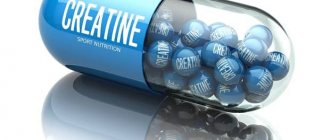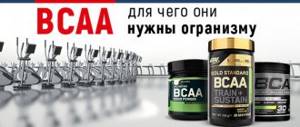- July 18, 2018
- Sports nutrition
- Tanya Gromova
The most famous dietary supplement, which is often used by athletes, is creatine, which is a combination of three essential amino acids. Creatine is also found in some foods, for example, chicken eggs, various types of fatty sea fish, and red meat. True, the substance obtained from the above-mentioned food products is not enough to build muscle mass. You will learn all the pros and cons of creatine for gaining muscle mass from the article.
What is creatine?
People involved in professional strength sports take an additional special supplement containing creatine in the required amount. Sports nutrition products with creatine include important amino acids such as methionine, glycine, and arginine, which enhance spermatogenesis, accelerate the process of tissue repair, and increase the level of growth hormone. In addition, all these amino acids are involved in DNA synthesis, enhance the production of nucleic acids, and participate in the formation of tendons and bone tissue.
Many people are interested in what creatine does? The peculiarity of the dietary supplement is that it begins to work only after ATP is broken down and energy is released. Next, the substance quickly restores ATP reserves in the muscles, reduces the time for further energy recovery, thanks to which the athlete trains more productively and intensively.
Effects of Creatine
Strength increase by 5-10%
The increase in strength indicators is directly proportional to the quality of muscle growth. However, taking creatine does not always have a similar effect. It can manifest itself much weaker, it depends on the individuality of each organism.
Increased muscle mass
Creatine itself retains water in the body. A weight gain of 2 to 5 kg per month is possible. The increase in lean muscle mass will depend on diet and nutrition in general. Also, taking it significantly improves muscle definition.
Everyone knows what “soreness” is, a burning sensation in the muscles after long strength training. Associated with the release of large amounts of lactic acid. Taking creatine will improve recovery processes in muscles and serve as a lactic acid buffer.
Increased strength training time
Strengthening short-term sports performance. Very well suited for those sports where you need colossal effort in a short period of time (sprinting, jumping), team sports (football, volleyball, hockey, etc.).
You must remember one thing - creatine is completely safe for the body. There are no known cases of overdose. It is stupid not to use all the positive qualities of this product. But you must follow the instructions for use from the manufacturer.
Application in sports
Creatine is one of the most famous substances for athletes around the world. However, for a high-quality effect, you need to know about the rules of application. After all, the number of techniques directly determines the result that everyone who plays sports wants to get. First of all, creatine is very similar to whey isolate both in structure and in terms of administration.
There are two options for taking the drug, which athletes rely on during training.
- The first is to take five grams every six hours, diluted in warm water or juice.
- The second option is to take ten grams every twelve hours, that is, twice a day.
Naturally, later you can increase the dosage and generally adjust it to yourself, based on your own feelings.
What is the price?
The average price of creatine is 1-2 rubles per 1 gram . That is, a container weighing 300 grams costs 350-600 rubles , and a container weighing 600 grams costs 600-1100 rubles .
The use of special additives allows you to achieve high-quality results in a shorter time. However, according to experts, every person who plays sports can do without any supplements and develop muscles gradually, without causing a drastic effect on the body.
Before using special additives, you must carefully read the instructions for use and consult with specialists.
Alexandrova Anastasia
Nutrition and healthy lifestyle specialist and author of myfitnesblog.com. For many years, she has successfully helped women and men lose weight and maintain a beautiful figure.
Coaches' opinion
Experienced trainers are accustomed to dividing the periods of taking creatine into loading and maintenance periods. The loading phase is needed to accumulate the substance in the body with a “reserve” and lasts about a week, then the maintenance phase begins, which stabilizes the body’s condition. Judging by the comments of experienced athletes, it is not always necessary to separate the use into phases, since the same dosage every day helps reduce the risk of side effects from creatine for muscle gain. However, each manufacturer has its own specific conditions for use, so you should carefully read the instructions so that the drug does not harm, but for good. The effect of this substance is active only if accompanied by training and a balanced diet.
What does creatine contain?
Many people may be interested in the question: “Isn’t it better to try to get enough creatine from food than to stuff yourself with supplements?”
Friends, I can say one thing - THIS IS ALMOST UNREAL!
For example, a pound of fresh, raw beef contains only 2 GRAMS of creatine!
Approximate content of creatine in food (in grams of creatine per 1000 grams of product):
- Cod – 3 g;
- Herring – 6.5-10 g;
- Salmon – 4.5 g;
- Tuna – 4 g;
- Beef – 4.5 g;
- Pork – 5 g;
- Milk – 0.1 g;
- Cranberry – 0.02 g;
Imagine how little this is if you need to additionally (besides food) receive 5-10 g of creatine per day.
Those. in order to get 5 g of creatine per day, we need to eat either a kilogram of salmon, beef, herring, or drink 50 liters of milk (this, of course, is unrealistic).
Plus, consuming such amounts of food that is quite difficult to digest can have a detrimental effect on the digestive system, kidneys, etc.
But you will have to eat this way not just for one day, but for at least 1-2 months to get at least some visible effect. Plus, during heat treatment (when you cook food on the stove or in the oven), a significant part of the creatine will be lost.
Therefore, the only correct and adequate solution would be to take creatine as a supplement to the main diet!
Rules
It is also worth remembering a few rules:
- Even with the smallest portion, it is necessary that at least 300 ml of water enter the body.
- It is imperative to take a break between doses every two months, as the muscles will quickly get used to the additional proteins and will no longer perceive them as they should.
- In no case should you take creatine before training, as this slows down the process of fat breakdown and disrupts the water-salt balance in the body.
- The best time to take it is after a workout for quick absorption.
- On days when there is no exercise, creatine should be taken in the morning, immediately after waking up.
- The best day to take the drug is the day of the carbohydrate window.
- It should be used with caution by people prone to food intolerance and those with chronic diseases.
Therefore, before taking it, you need to check for the presence of the above factors. In general, creatine is considered one of the safest food additives among all others, since it does not contain any unnecessary harmful components with serious side effects.
How to take creatine?
It is recommended to use creatine over a course of two months, but it is possible to use the substance on an ongoing basis:
- On days when there is a force load on the body, it is recommended to drink a certain dose of the substance per day before starting training and after training.
- On days when a person does not exercise, the supplement is taken once a day in the morning, in the same dosage.
- In parallel with the use of the supplement, it is recommended to use protein, this allows creatine to be better absorbed and produce more energy.
To prepare a cocktail, you need to add the powder to water using a dosed spoon, and drink the liquid after mixing well. To speed up the absorption of the supplement, it is recommended to dilute the powder in a liquid that contains sugar, such as juice or sweet water.
Pros and cons of creatine
Creatine is a completely natural and approved nutritional supplement that makes it possible to increase the energy potential of an athlete. Nowadays, the diet of athletes is rarely complete without this supplement. It helps to quickly realize achievements in sports. This substance has its positive and negative qualities.
How does creatine work?
In order for muscles to contract quickly, it is necessary to reduce the group of phosphate substances. This process is not carried out by the muscles themselves in full, and the proper formation of adenophosphates does not occur.
Adenophosphates provide energy for muscle tissue; the absence of such a component leads to muscle wasting and reduces their performance during physical activity.
Regular consumption of creatine allows muscle tissue to produce adenoflasphate molecules faster and more, thereby increasing the energy that is necessary for greater productivity of muscle tissue.
If the sports supplement is used correctly, endurance increases and the athlete feels less fatigue.
Positive sides
When an athlete trains, the muscles must receive sufficient energy. The use of creatine allows you to moderately consume glycogen and ATP reserves, which, in turn, increases strength indicators and working scales. There is a visual increase in muscles as the drug accumulates fluid in their cells. However, when the course of taking this substance is completed, the muscles can return to their normal state again. Of course, they will not sag and deflate - liquid will gradually leave them, which will make them smaller.
Creatine improves the quality of the composition of sarcoplasm - the nutrient medium located around muscle fibers. As a result, less glycogen will be consumed, and muscles will recover much faster. To summarize, it can be noted that after taking creatine, muscle performance during training increases significantly; they seem more powerful and plump.
Creatine monohydrate and coffee
Many athletes and even, surprisingly, coaches argue on this topic. Some people give up coffee and even tea while taking creatine, because... One 1996 study found that "caffeine reduces the loading of creatine into muscle tissue."
All sources claiming the same thing refer only to him.
Another study was conducted that confirmed this assumption. It would seem that’s it! Creatine and coffee don't mix.
But let's not rush to conclusions, friends.
ERRORS WERE MADE IN BOTH STUDIES! Crossover design in the first and erroneous protocol in the second.
In the first case, the study took place over a limited period of time, and creatine still remained in the blood at the moment when the subjects switched to placebo.
And in the second case, as I said, the WRONG PROTOCOL was used! Accordingly, the results of the above studies can be considered invalid.
Therefore, a THIRD STUDY was conducted! No errors in design or protocol. It REFUTED the assumption that caffeine and creatine are incompatible.
The average body weight after taking creatine and caffeine, and just creatine remained approximately the same, with the only difference being that those who used caffeine and creatine together gained more DRY MUSCLE MASS and had less fat.
Negative sides
Yes, creatine has several disadvantages, but it is worth noting that they are quite minor. Thus, the substance tends to accumulate water in muscle cells. You should stop using creatine if the athlete often experiences swelling: when taking this substance you need to drink water, which can only worsen the situation. Some athletes, after taking the drug, note the appearance of intestinal spasms, nausea and indigestion. Individual intolerance should also not be ignored.
Another disadvantage of creatine is the possible occurrence of dehydration, which occurs with minimal water consumption. You should not remove excess water with medications, as this can be harmful to health.
If you have doubts about whether you should take creatine, you can buy several samples. This amount will be enough to form your own opinion about it.
After you have become familiar with the pros and cons of creatine, what this product provides and how to take it, you can make a choice of drug.
Which is better?
Today on the sports nutrition market you can find many options for a nutritional supplement that is widely known and revered among sports fans, like creatine. With its pros and cons, it can rightfully be considered one of the most effective and actually working supplements. Having a number of advantages, it is simply indispensable for fans of bodybuilding, powerlifting and other strength sports. In fact, it is a natural energy drink. It increases strength characteristics and promotes faster recovery. And at the same time it has no pronounced disadvantages. But which creatine capsules are best? How to choose from the many proposals the option that will be most effective?
Today on the sports nutrition market you can find many options for this sports supplement. In turn, this confuses athletes. After all, they are forced to study this entire range, compare and spend a lot of time finding the optimal solution for themselves. In fact, everything is not that difficult. Today, the best and most effective is monohydrate. Its effectiveness has been tested by time and the experience of many athletes.
Creatine monohydrate can be found in several versions. These are tablets, capsules and powder. Which one do you prefer? Each of these options has its own advantages. Capsules and tablets are more convenient to take. No need to think about what to dissolve them in. This is especially true if you take the drug with you to the gym for training. As for creatine powder, the dosage is important. If it is already dosed in tablets or capsules, then in the case of powder it must first be measured. So sports nutrition with creatine in tablets and capsules is more practical.
But it is worth noting that in powder form, sports nutrition is absorbed faster. After all, the body receives a ready-made product. And in the case of capsules, it takes time to break it down. Creatine tablets are also not absorbed as quickly as powdered ones. After all, tablets contain binders (due to which the tablet retains its shape). They slow down the absorption time of the substance. The main thing is that the risk of side effects from creatine after use is quite low.
It is also worth noting that the price for the drug in capsules and tablets is higher than for the powder version. So if you only take creatine at home and don't take it with you to the gym, then the powder form is the best option. And remember, the best absorption of creatine occurs in the presence of insulin. Therefore, it is better to drink it with sweet juice.
Which creatine should you choose?
When choosing a supplement, you may encounter the problem of how to choose the right nutrition.
The following types of sports supplements exist:
- Creatine monohydrate - the supplement is completely absorbed by the stomach and allows you to produce much more energy. It is used for heavy sports and helps withstand high power loads.
- Creatine phosphate is most often used for intravenous use and is practically not used in food. However, this type of supplement is not particularly popular among athletes, since energy production does not occur to the full extent, and there is also an inconvenience in the method of its use.
- Creatine citrate is quickly absorbed by the body due to the presence of citric acid in the composition, and also releases a large amount of energy necessary for prolonged physical activity.
When choosing a sports supplement, you should consider the following features:
- Before choosing a supplement, you need to decide what type of substance will be most convenient to take: liquid, powder, capsules.
- For beginners, the best type of supplement is creatine citrate, as it is absorbed better by the body and is suitable for athletes at any training level.
- Pay attention to the manufacturer; do not purchase the supplement from dubious manufacturers.
All types of creatine are suitable for beginners, the only difference is in the dosage of use. The most convenient supplement is in the form of capsules, which you can always carry with you. However, many athletes prefer the supplement in powder form, from which a kind of cocktail is made.











